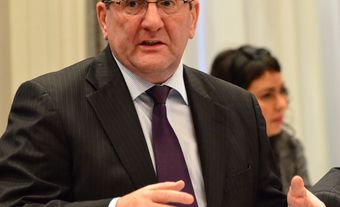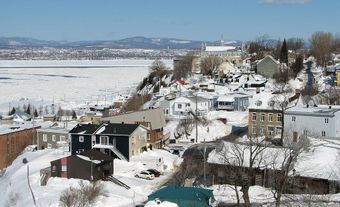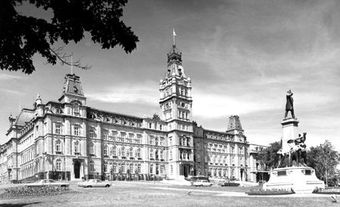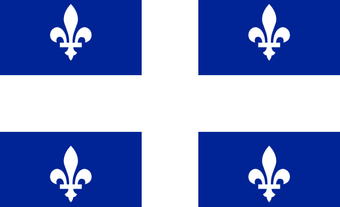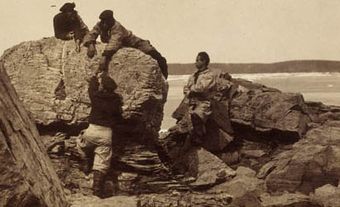Quebec City, Quebec, founded in 1608, population 549,459 (2021 census), 531,902 (2016 census). Quebec City, the capital of the province of Quebec, is located on the north shore of the St. Lawrence River where it meets the Rivière Saint-Charles. Here, the St. Lawrence narrows to a width of just over 1 km, and navigation is made difficult by a group of islands, the largest of which is Île d'Orléans. Cap-Diamant, a promontory with an elevation of 98 m, dominates the site and was used effectively as a fortification, earning Quebec City the name "Gibraltar of North America." The name "Quebec" is probably derived from an Algonquian word meaning "narrowing of the river."
Settlement
For several thousand years prior to the arrival of the Europeans, the site of Quebec City was occupied by Indigenous hunters and fishermen. In 1535, Jacques Cartier discovered a fairly large Iroquoian village, Stadacona, whose 1,000 or so inhabitants lived from fishing, hunting and the cultivation of corn. Sometime between 1543 and 1608, when Samuel de Champlain arrived at the site, Stadaconans had disappeared and been replaced by the occasional nomadic Algonquians, likely Montagnais-Naskapi.
With a mandate from the king of France, Cartier wintered near Stadacona in 1535–36 and returned in 1541–42, spending a difficult winter at Cap Rouge, a few kilometres upriver, before heading home with barrels of worthless minerals (see Diamonds of Canada). Jean-François de la Rocque Roberval (1542–43) spent the following winter at Cap Rouge, but the failure of these early expeditions diminished French interest in the area, and a permanent settlement was not established until 1608 when Champlain founded a trading post. The post was captured by the Kirke brothers in 1629, but was restored to the French by the Treaty of Saint-Germain in 1632. The town successfully repulsed assaults by Sir William Phips in 1690, but was conquered by the British in 1759 (see Battle of the Plains of Abraham). It resisted an attempted invasion by a large American force in 1775–76, so the colony remained under British control.
Development
St. Lawrence River determined the nature of its development. In the age of sail, it held a dominant position as a port of entry and exit for ocean-going vessels. It quickly became the transfer port for domestic and foreign trade (especially furs and timber) and the arrival and departure point for travellers and immigrants to North America. From the beginning, its location made Quebec City a political, administrative and military centre.
The long delay in establishing a rail link to the city, the technological developments in ocean-going vessels that enabled them to bypass the city and navigate directly to Montréal, and finally the shift of population and the economy westward, all tended to reduce Quebec City's importance in the mid-19th century. Despite repeated efforts, the city was unable to maintain its earlier position as a focus of economic production and trade, and it gradually became a provincial and regional administrative centre.
Between 1960 and 1980, the considerable growth of the provincial government accelerated the growth of the city and its suburbs and gave added emphasis to the relative importance of its administrative function. However, since the 1980s, and especially in the 1990s, this trend levelled off somewhat due to cuts in government services. The city has also continued to develop as a cultural centre and tourist destination (see Tourism).
Cityscape
In the 17th century, the inhabitants of Quebec City first occupied the narrow strip of land between the promontory and the port (Lower Town), and then the promontory itself, following in the wake of the religious institutions and colonial administration that occupied Upper Town. This expansion was strongly influenced by the construction of and improvements to the town's fortifications, which were established principally in the Upper Town but also on the banks of the river. (See Fortifications of Quebec National Historic Site)
The fortifications and military barracks occupied a considerable area and restricted the establishment of a residential civilian population, which was limited already by the development of religious institutions (the Bishop's Palace, the cathedral, the seminary, colleges and convents, the Hôtel-Dieu and the Château Saint-Louis). Lower Town was for many years the residential and commercial centre. Both parts form the core of the old city, which is still well preserved and has been partially reconstructed as part of the Place Royale project.
At the end of the French regime, Lower Town stretched along the port toward the Intendant's Palace, to the north of the promontory. During the 19th century, the town broke out of its fortified confines and stretched westward on the promontory, along the banks of the Rivière Saint-Charles and to the foot of the north face of the promontory. These new parts of town were often built hastily and of wood, and fell victim to a number of major fires (Saint-Roch, 1845; Saint-Sauveur, 1866, 1870 and 1889; and Saint-Jean-Baptiste, 1845, 1876 and 1881). The result was major reconstruction and improved protective infrastructures (water supply, firefighting services, etc.).

Growth to the west and north of the city has been even more substantial in the 20th century, particularly since the 1950s. The small parishes in outlying areas grew quickly as both residential and commercial cities: Sillery, Sainte-Foy, Charlesbourg, Cap-Rouge, L’Ancienne-Lorette, etc. Although the downtown area was quite radically transformed with the appearance of private and governmental buildings and a few major hotels, the historic character of the old city has been largely preserved. The modern buildings blend with the characteristic landscape of Quebec City: the promontory, fortifications, Château Frontenac, Parliament Buildings, Rivière Saint-Charles, the Port and the Quebec Bridge. The preservation of its fortifications gives Quebec City the distinction of being the only walled city in North America.
Population
Although Quebec City was the capital of the French empire in North America, for many years it was little more than a large village (see New France). In 1608 it had 28 inhabitants, and by the time of the Conquest in 1759, its population only slightly exceeded 8,000. Growth was rapid in the first half of the 19th century, and by 1861 it numbered nearly 60,000 inhabitants. The growth resulted from the economic expansion associated mainly with the timber trade and the important political and administrative activities centered in the city.
Quebec City was also both the entry and transit port for the substantial annual influx of immigrants heading towards Upper Canada and the rest of North America. In some years the city’s population doubled during the summer, aggravating many attendant problems (unsanitary conditions and epidemics).
As a result of the gradual slowdown in the timber trade and shipbuilding in the second half of the 19th century, the population of the city remained relatively stable until the early 20th century. In fact, the Lower and Upper Town experienced a decline as people moved to the new areas, particularly Saint-Roch. The overall population increase in a 40-year period, 1861 to 1901, was only 14.7 per cent (60,000 to 68,840).
Besides experiencing unfavourable economic conditions, the old city lacked residential space. Only with the amalgamation of small outlying municipalities did its population begin to grow at the beginning of the 20th century. Metropolitan Quebec nevertheless grew more rapidly from the 1950s until the end of the 1970s, especially in the new suburbs. In the early 1980s, this growth again slowed, partly as a result of stabilization of growth in the province overall.
According to the 2021 census, the population of the city itself was 549,459. When added to the populations of the suburbs, the total population of Quebec City’s metropolitan area is 839,311.
Prior to the Conquest, Quebec City’s population had been French. In the early 19th century this changed with the influx of British immigrants. In 1851, 43 per cent of the city’s population was comprised of British and other groups, which decreased slightly to 41 per cent in 1861. This high proportion dropped rapidly as immigration to Quebec City stopped and as many British immigrants moved to other parts of Canada and to United States. By 1871, the percentage of non-francophones had fallen to 31.5 per cent, to 10 per cent in 1921, 6 per cent in 1971, and finally, by 2011, to 4 per cent. According to the 2021 census, people citing Canadian ethnic origins make up the largest ethnic group, at 33.1 per cent of the city’s population, followed by French (27.6 per cent) and Québécois (12.8 per cent). Visible minorities account for 9.4 per cent of city residents, with Black, Latin American and Arab people making up the largest communities within this group.
Economy, Transportation and Labour Force
The early economy of Quebec City was directly dependent upon its activities as a transit port for basic products exported to Europe (furs, cereals and lumber) and for imported manufactured products. The considerable expansion of this trade enabled Quebec City to maintain a relatively competitive position with Montreal as the major trading centre of the province until the mid-19th century.
At that time, the commercial position of Quebec City was seriously affected by the decline in the timber trade and the shift from raw timber to lumber; the development of railway networks that bypassed the city (the Grand Trunk Pacific Railway passed on the south shore, opposite the city); the weakness of the city’s hinterland; the dredging of the St. Lawrence River between Quebec City and Montreal; the expansion of economic relations with the United States; and, the impact of technological change on trade and transportation. Montreal rapidly acquired a dominant position in the second half of the 19th century in trade and finance, transportation and industry.
Quebec City’s middle class, which was already declining in numbers, attempted to maintain its position but failed. It struggled to attract the transcontinental railways, such as the Quebec, Montreal, Ottawa and Occident Railway as part of the Canadian Pacific Railway (which in 1879, was the first railway to reach the city), as well as the National Transcontinental Railway and the Canadian Northern Railway, and to have them adopt the port of Quebec City as their ocean terminal.
Efforts were also made to have the two shores of the river connected by a bridge. The Quebec Bridge (1900–1917) is still the largest cantilevered bridge in the world, but experienced serious construction difficulties in 1907 and 1916 (see Quebec Bridge Disaster). The bridge actually helped promote the circulation of products to ports farther east. A second bridge, the Pierre-Laporte, was built in 1970. It is a suspension bridge, located a few hundred metres from the earlier one.
In the middle of the 19th century, the city went through an industrial revolution, particularly in the footwear industry, which gradually became the largest source of employment for the region. However, the city was unable to maintain growth in its manufacturing sector, and the footwear industry declined in the 1920s. Even though various other industries appeared and disappeared, and offered employment to a significant number of people, they did not manage to diversify the city’s industrial base. These industries included shipbuilding, breweries, corsetry, tobacco products, munitions, and pulp and paper.
Today, most jobs in Quebec City are concentrated in health care and social assistance, public administration and retail. The city benefits from its status as the provincial capital and the regional administrative and services centre. It also attracts an increasing number of tourists.
Government and Politics
From 1765 to 1833, and from 1835 to 1840, the city was administered by a commission of justices of the peace appointed by the governor and composed largely of landowners, French Canadian professionals and British merchants. The commission was responsible for ensuring that the orders of the legislature of Lower Canada were respected. Following pressure from the local population, Quebec City received its first municipal charter in 1833. This lasted until 1835. A second was issued in 1840. These charters established an elected municipal council with the power to adopt regulations in their area of jurisdiction.
From 1833 to 1856, and 1870 to 1908, the mayor was elected by the reeves and councillors, and then directly by citizens (property owners and tenants) by secret ballot from 1856 to 1870 and after 1908. Furthermore, the number of reeves, councillors and districts changed on many occasions as a result of annexations, in particular those of Saint-Sauveur (1889), Saint-Malo (1908), Limoilou (1909), Montcalm (1913), Notre-Dame-des-Anges (1924), Les Saules (1969), Duberger (1970), Neufchatel (1971) and Charlesbourg Ouest (1973).
Formed in 1970, the urban community of Quebec City includes 13 municipalities on the north shore and is responsible for planning, public transit (STCUQ), property assessment, and industrial and tourism promotion. In 2001, as part of a large-scale provincial government project to amalgamate municipalities (often referred to as the “forced amalgamation” project), the municipalities of the urban community were joined together to form the new city of Quebec. In 2004, a vote was held on de-amalgamation: the new city lost Saint-Augustin-de-Desmaures and L’Ancienne-Lorette but otherwise remained intact.
The role Quebec City played as a "national" capital until 1840 (and subsequently 1851–55 and 1859–65, during the Union period), and as a provincial capital since 1867, has given it a special relationship with national, provincial and municipal politicians. So much so, in fact, that with the exception of a few businessmen prior to 1870, most of the city's mayors have also been involved in political careers at higher levels before, after and even during their mandates. One of the most famous mayors, Simon-Napoléon Parent (1894–1906), was also Minister of Lands and Forests (1897–1905) and premier of Quebec (1900–05). A Commission de la capitale nationale du Quebec was established in 1995 to promote and develop all facets of Quebec City as a "national" capital.
The current mayor is Bruno Marchand who replaced Régis Labeaume in 2021.
Cultural Life
The city remains a major centre of French culture and the seat of the only francophone government in North America. In addition to conserving these traditions, it has managed to maintain a greater cultural homogeneity than Montréal, the other major pole of French culture.
Its teaching institutions include the Séminaire de Québec (1668) and Université Laval (1852). Until 1920, the latter was the only francophone university in the province; its satellite campus in Montréal, founded in 1876, became an independent university known as the Université de Montréal (1920). This situation often produced acrimony within the ranks of the clergy and in provincial political circles. Long located in the historic district of Old Quebec, Université Laval gradually moved to a spacious new campus in the suburbs from the 1950s on. Starting in the 1960s, the administrative headquarters and several component institutions of the Université du Québec were established in Quebec City.
The historical character of Quebec City is reflected in the architecture of the old city, which has been the subject of major restorations and has become the site of exceptional museums. In 1985, this part of the city was recognized as a United Nations World Heritage Site. The municipal, provincial and federal governments have combined their efforts to restore Place Royale, Artillery Park and the fortifications (Quebec Citadel, walls, gates, south shore forts), the Old Port, the Voûtes du Palais, the Séminaire de Québec, a number of private religious museums, the Musée de la civilisation (1988), and the Musée de l'Amérique française (1806, 1993). Quebec City was chosen in 1993 as host for the general secretariat of the Organization of World Heritage Cities.
The Musée du Québec (1933) was renamed the Musée national des beaux-arts du Québec in 2002. It contains collections of ancient and modern works and is part of a large urban park, the Plains of Abraham, or Parc des Champs-de-Bataille (1908), which commemorates the battle leading to the fall of the city in 1759 and ultimately of New France to the British army a year later (see Battle of the Plains of Abraham). There is also an aquarium near the Quebec Bridge and the Grand Théâtre de Québec (1971), home of the Orchestre symphonique de Québec.
A number of downhill and cross-country ski centres, including Mont Sainte-Anne, Stoneham, and Lac-Beauport, are located within a few minutes of the city. After having excellent minor league hockey teams for many years, Quebec City finally entered the realm of major league hockey with the Québec Nordiques (1972), who were members of the National Hockey League (NHL) from 1979 to 1995. The team was sold and moved to Denver, Colorado. As the Avalanche, this team won the Stanley Cup in 1996 and again in 2001. A new multi-purpose arena is due to open in 2015, and it is hoped that this new facility will bring professional hockey back to the area. The city is also host to an international peewee hockey tournament.
Tourists and residents are attracted by a number of popular events: the Quebec Winter Carnival (see Winter Festivals), which has been held every February since 1954; the Quebec City International Summer Festival each July, and a number of major anniversaries, including the 300th anniversary of the founding of Quebec City in 1908, the 375th in 1983, the 400th in 2008, and the 450th anniversary of Jacques Cartier's arrival in 1984. Increasingly, summer events such as these give people an opportunity to enjoy many international-calibre musical performances on the Plains of Abraham.
Of Quebec City's many literary figures, mention should be made of Roger Lemelin, whose novels depict the working-class districts of the city. Robert Lepage has made a remarkable contribution to theatre, as has Ex Machina, his international-calibre creative multimedia company, established in 1997. Five TV stations serve the city, one of which is English, there are several community stations, and there are a number of radio stations and two daily newspapers, Le Soleil and the Journal de Québec.

 Share on Facebook
Share on Facebook Share on X
Share on X Share by Email
Share by Email Share on Google Classroom
Share on Google Classroom









